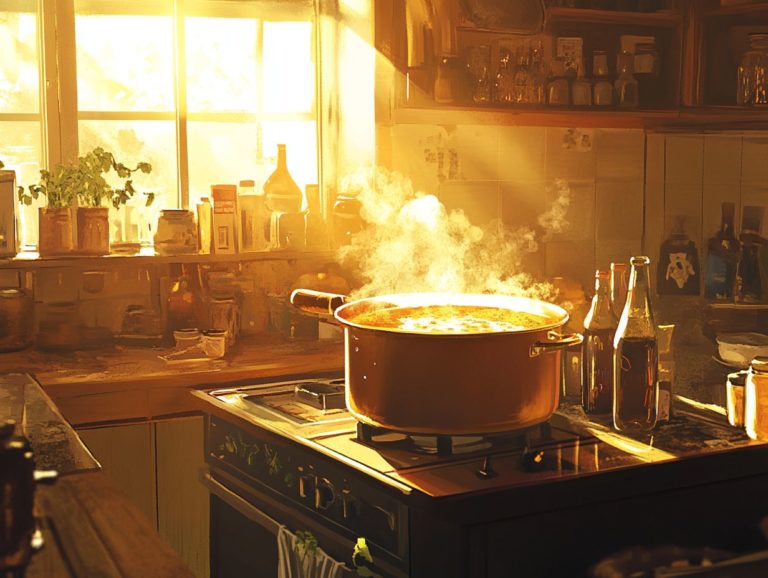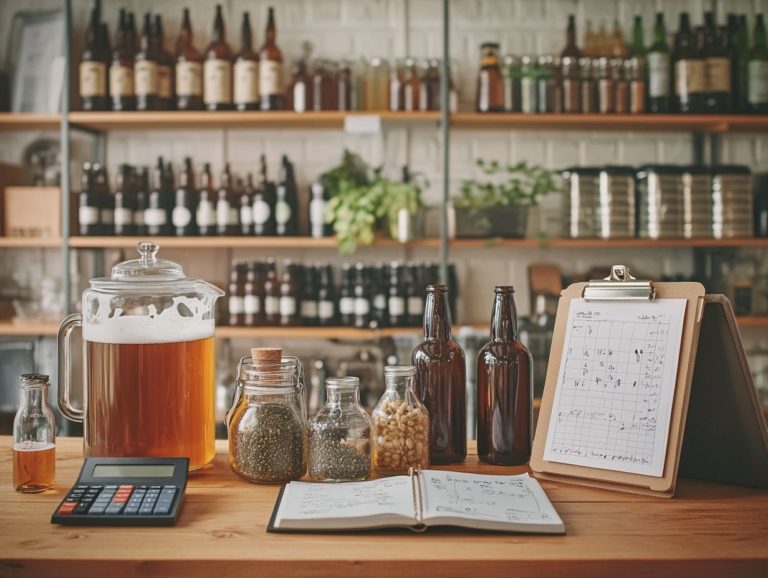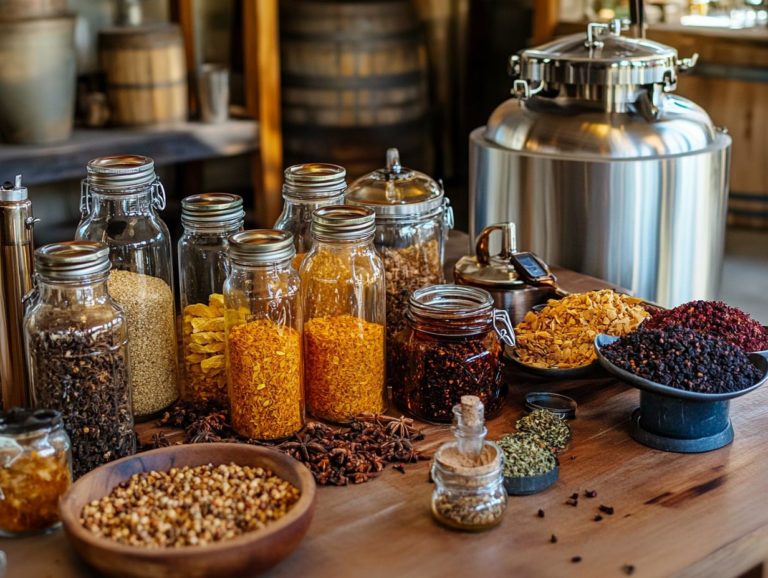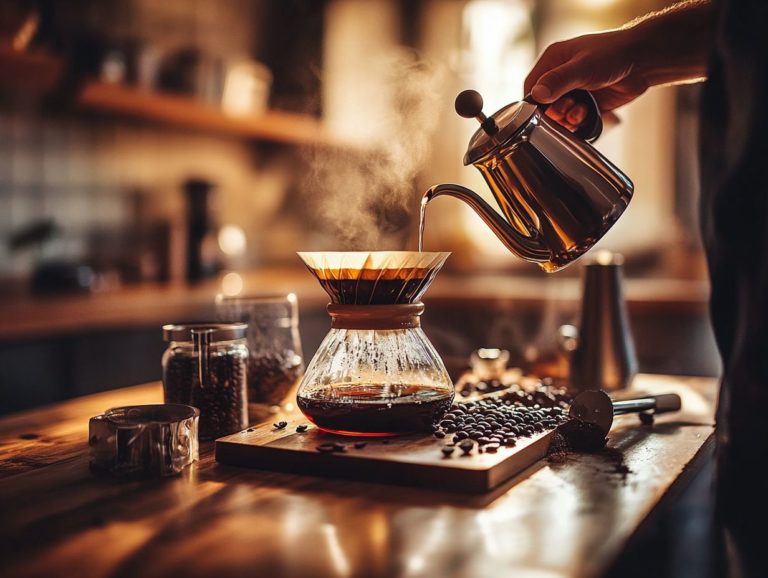How Do I Choose the Right Yeast?
Get ready to unleash the power of yeast in your baking adventures! Yeast is truly a remarkable ingredient, serving as a crucial element in both baking and brewing. It transforms simple mixtures into delectable creations, whether it’s for bread or beer.
By understanding the various types of yeast active dry, instant, fresh, and even brewing yeasts like ale yeast and lager yeast you can significantly enhance your culinary results.
This guide delves into how to select the right yeast for your recipe and the factors worth considering, such as temperature range and the ability of yeast to clump together (flocculation). It also covers the common pitfalls you should steer clear of.
Regardless of whether you re a seasoned baker or a novice in the kitchen, mastering yeast can elevate your cooking game to new heights.
Contents
- Key Takeaways:
- What Is Yeast?
- What Are the Different Types of Yeast?
- What Are the Factors to Consider When Choosing Yeast?
- How Do I Know If My Yeast Is Active?
- Baking with Yeast: Essential Tests and Common Mistakes
- 1. Temperature Test
- 2. Smell Test
- 3. What Are the Common Mistakes When Using Yeast?
- Frequently Asked Questions
- How Do I Choose the Right Yeast?
- What factors should I consider when choosing yeast?
- What is the difference between active dry yeast and instant yeast?
- Can I use any type of yeast for bread making?
- How can I determine the best yeast to use for my recipe?
- Can I substitute one type of yeast for another in a recipe?
- Should I use fresh or dried yeast for my recipe?
Key Takeaways:
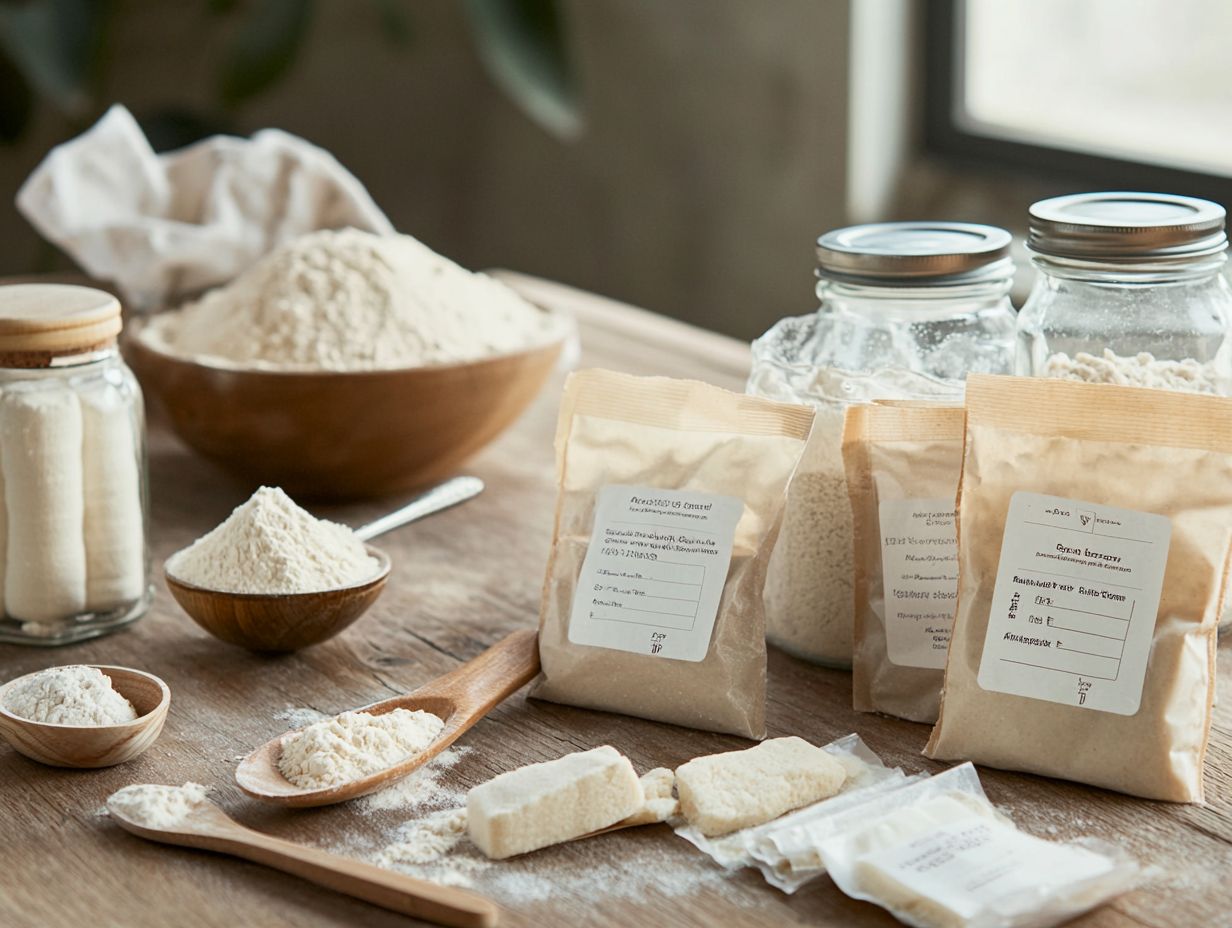
- Choose the right yeast by considering your recipe’s needs think about rising time, temperature, flavor, and how to store it!
- Want to know if your yeast is active? Simply proof it by dissolving in warm water, checking its smell, and watching for bubbles!
- Avoid common pitfalls like using expired yeast or exposing it to direct salt. Always check those best by dates to ensure top performance!
What Is Yeast?
Yeast serves as a vital leavening agent in the art of baking. It orchestrates the fermentation process that generates carbon dioxide, a key player in making dough rise.
This microscopic fungus, predominantly represented by the species Saccharomyces cerevisiae, is essential not only in bread-making but also in crafting a delightful array of baked goods that captivate both home bakers and professional baking enthusiasts. Saccharomyces cerevisiae also plays a crucial role in brewing, particularly in producing ales such as the Sierra Nevada Pale Ale.
The fermentation process does more than just produce gas; it enriches the unique flavor profiles found in artisan breads and quick breads. This elevates your baking experience to new heights.
During fermentation, yeast also produces alcohol and other byproducts that contribute to the final sensory profile of the baked goods.
What Are the Different Types of Yeast?
You ll find several types of yeast that are staples in the baking world, each boasting its own distinct characteristics and benefits. Active Dry Yeast, Instant Yeast, Fresh Yeast, and Rapid Rise Yeast are the primary strains that both home bakers and professionals rely on to achieve the perfect fermentation rates and flavor profiles in their recipes.
Popular brands like Red Star Yeast, SAF Yeast, and BellaRise Yeast are often used in various baking applications. By grasping the nuances of these different yeasts, you can elevate your baking experience and significantly enhance the quality of your final creations.
1. Active Dry Yeast
Active Dry Yeast is a favorite among home bakers, celebrated for its impressive shelf life and adaptability across a range of baking recipes. Its granulated form requires a little proofing before use, a crucial step that activates the yeast cells and ensures optimal moisture content for effective fermentation.
Mastering the art of yeast management can profoundly influence the rise and flavor profile of your dough. Brands like King Arthur Flour often recommend specific yeast types in their recipes for optimal results.
To proof Active Dry Yeast, all you need to do is dissolve it in warm water with a pinch of sugar. Let it sit until a frothy layer forms on top this usually takes about 5 to 10 minutes. This step is essential; it confirms that your yeast is alive and primed to work its magic in your dough.
When you re not using it, make sure to store Active Dry Yeast in an airtight container, ideally in a cool, dark place or even in the refrigerator. This will help maintain its potency.
This yeast shines in various breads, from classic French baguettes to rich brioche, English muffins, Crescent Dinner Rolls, and hearty whole wheat loaves, proving its versatility in the baking world.
2. Instant Yeast
With Instant Yeast, you can create delicious baked goods in a flash! Instant Yeast, often referred to as rapid-rise yeast, is your go-to companion for a faster fermentation process in the kitchen. This type of yeast is known for its high fermentation efficiency, making it a popular choice for both baking and brewing applications.
Unlike Active Dry Yeast, there’s no need for proofing with this gem; you can mix it directly with your dry ingredients, giving your dough a quick rise. This makes it the perfect choice for recipes that demand a shortened fermentation time without sacrificing flavor.
If you’re eager to whip up scrumptious baked goods in no time, Instant Yeast brings a multitude of benefits to the table. It’s especially effective in recipes like pizza dough, focaccia, and dinner rolls, where that light, airy texture is essential. Its rapid action allows you to experiment with various types of bread, significantly cutting down on waiting times.
You can store Instant Yeast for extended periods, making it an invaluable staple in your pantry. This efficiency elevates your baking experience, enabling you to craft delightful treats without the usual lengthy fermentation waits.
3. Fresh Yeast
Fresh Yeast, often referred to as cake yeast, is the secret weapon of professional bakers, prized for its vibrant flavor profile and exceptional leavening power. This yeast is quite perishable and demands specific fermentation conditions to maintain its potency, making it essential for crafting rich, flavorful breads. Its use dates back to World War II when it was a staple in many baking recipes.
The benefits of using Fresh Yeast extend beyond its impressive leavening capabilities; it adds a subtle sweetness and tanginess that elevates your baked goods to extraordinary levels. To ensure its effectiveness, proper handling is crucial keep it chilled and use it promptly, as its viability diminishes over time.
Fresh Yeast shines particularly in recipes that benefit from a longer fermentation period, such as artisan loaves and enriched doughs like brioche. Its unique qualities significantly enhance both the taste and texture of your creations.
For anyone diving into the art of baking, Fresh Yeast unlocks a realm of culinary possibilities, allowing you to produce breads that are not only delicious but also rich in depth and character. Proper yeast management, including maintaining the right fermentation environment, is crucial for achieving the desired results.
4. Rapid Rise Yeast
Rapid Rise Yeast is a specialized strain crafted to expedite the fermentation process, allowing your dough to rise swiftly without sacrificing the quality of the final product. This type of yeast is particularly useful in baking quick breads and other recipes where time is of the essence, making it a choice for busy home bakers like you.
Its unique characteristics, including enhanced leavening, resilience, and high alcohol tolerance, enable you to achieve light, airy textures that can be challenging with traditional yeast options. One of the standout benefits of using this yeast is its ability to significantly shorten preparation time an invaluable advantage when you re juggling multiple tasks in the kitchen.
Rapid Rise Yeast also boasts a more predictable proofing time, ensuring consistent results across various recipes, from pizza dough to dinner rolls. Its versatility makes this yeast an essential ingredient for anyone looking to streamline their baking efforts while still enjoying the satisfaction of homemade delights.
What Are the Factors to Consider When Choosing Yeast?
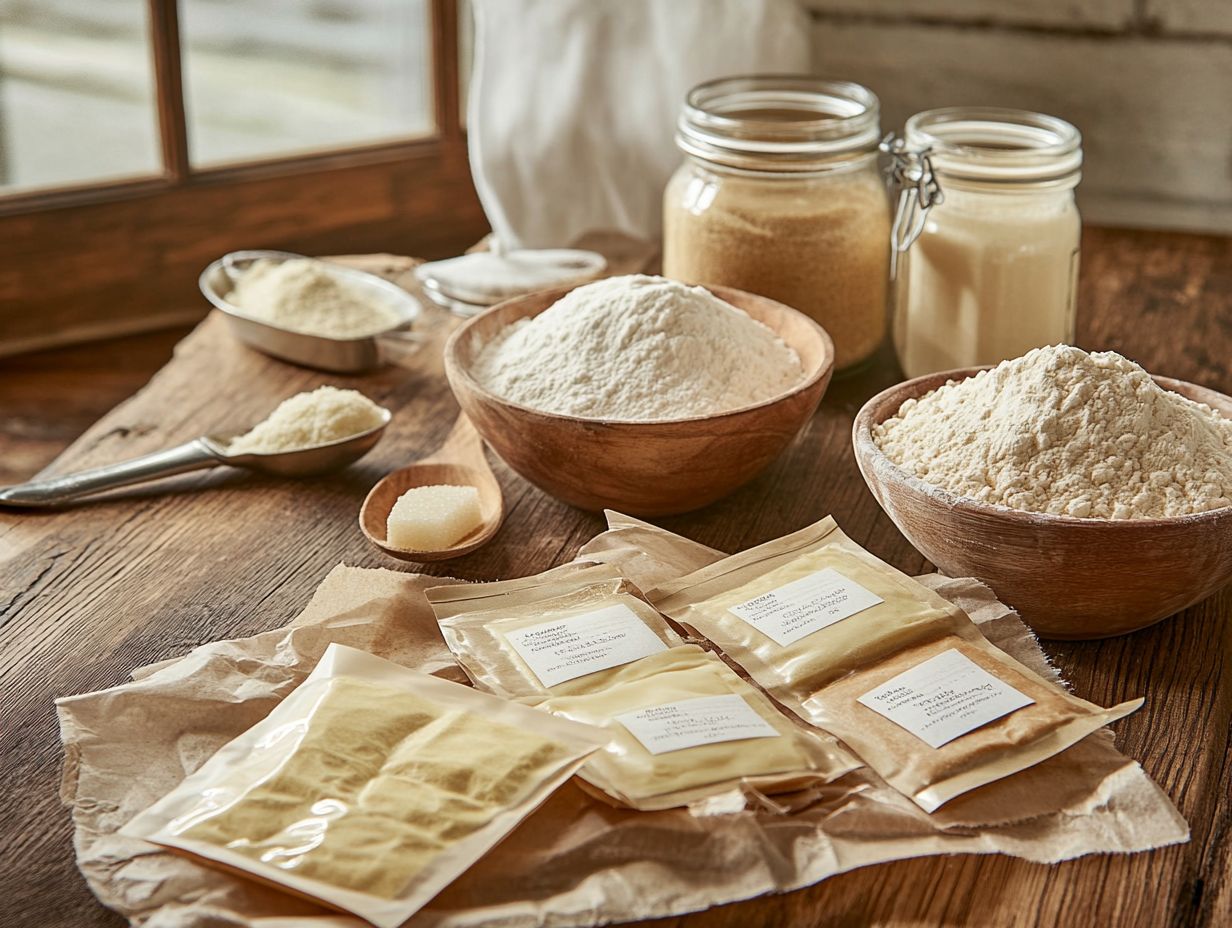
When selecting the perfect yeast for your baking endeavors, it’s essential to consider several key factors. These include the formulation of your recipe, the desired rising time, flavor profile, and even the flocculation ability of the yeast strain you choose.
Familiarizing yourself with the optimal temperature range for yeast activity, as well as its storage requirements, shelf life, and alcohol tolerance, can profoundly influence your baking results. Each of these elements is crucial in determining which type of yeast will deliver the most satisfying results for your baked creations.
In summary, whether you choose Instant Yeast, Fresh Yeast, or Rapid Rise Yeast, each type offers unique benefits tailored to different baking needs. Experiment with these options to find the perfect yeast for your culinary adventures!
1. Type of Recipe
The type of recipe you choose plays a crucial role in determining which yeast you should use, as different baked goods require varying leavening agents for optimal results. From artisan breads to quick breads and various dough formulations, understanding the specific yeast needs is essential for achieving the texture and rise you desire. Additionally, the flocculation and attenuation characteristics of the yeast strain should also be considered in your yeast selection process.
For instance, when preparing a classic sourdough bread, you’ll rely on wild yeast and a longer fermentation process to develop that distinct flavor and chewy crust. On the other hand, a soft roll recipe may call for instant yeast, allowing for a quicker rise and a tender crumb. In terms of pizza dough, using a high-protein flour combined with active dry yeast or Red Star Yeast is key to achieving that perfect chewy texture and those delightful air pockets.
By tailoring your yeast selections according to the specifics of the dough and the intended baked good, you can elevate not only the quality of your creations but also your overall baking experience.
2. Rising Time
When choosing yeast, rising time is a crucial factor you can t overlook, as different types of yeast rise at varying speeds, which can significantly impact your baking timeline. For a quick rise, Instant Yeast or Rapid Rise Yeast are excellent options, particularly for busy home bakers.
For instance, if you opt for Rapid Rise Yeast, you ll find that it can drastically reduce rising time, making it a perfect choice for those moments when you re eager to bake efficiently without compromising on quality.
Conversely, traditional yeast strains like active dry yeast typically require a longer fermentation period, allowing for the development of deeper flavors. This longer process is essential for artisan breads, where taste and texture take center stage. The unique fermentation processes of each yeast strain lead to distinct flavor profiles and crust characteristics, underscoring the importance of understanding what each type brings to the table. Additionally, considering yeast characteristics such as attenuation and fermentation byproducts can help achieve the desired sensory profile in your baked goods.
Moreover, slower rising times can facilitate enhanced gluten development, impacting the dough’s structure and elasticity. Therefore, your choice of yeast not only dictates how quickly your dough rises but also plays a vital role in the overall success of your baking process and the final quality of your delicious creation.
3. Temperature
The temperature range in which yeast thrives is a crucial aspect you should consider, as different yeast strains require specific fermentation environments that significantly affect their performance. By maintaining the ideal temperature during fermentation, you ensure that the yeast remains active, which promotes optimal rising and flavor development in your dough.
For example, many types of baker’s yeast flourish at temperatures between 75 F and 85 F. This warm environment accelerates the fermentation process, resulting in a sweeter taste and improved texture in your bread. On the other hand, lager yeast prefers cooler conditions, around 45 F to 55 F, promoting a slower fermentation that enhances the beer’s crispness and minimizes fruity esters.
Understanding how temperature impacts yeast activity not only helps you achieve the desired results but also allows you to sidestep fermentation-related issues, such as slow or stuck fermentation, which could compromise the final product. Thus, curating the right fermentation environment is essential for anyone aspiring to master the art of baking or brewing.
4. Flavor Profile
The flavor profile of your baked goods hinges on the yeast you choose. Different strains produce a variety of fermentation byproducts that shape the overall taste. Understanding how your yeast selection impacts flavor can enable you to create products that align perfectly with your culinary vision.
Sourdough Bread
Take sourdough bread, for example. Its distinctive tang comes from the wild yeast and bacteria in the starter, which develop a complex blend of acetic and lactic acids during fermentation.
Saccharomyces cerevisiae
Bakers and brewers often prefer Saccharomyces cerevisiae for its consistent performance and delightful sweet nutty undertones. This makes it the go-to choice for crafting rich, fluffy brioche.
Champagne Yeast
Champagne yeast works wonders in certain pastries. It enhances fruity esters and adds a touch of effervescence, or bubbles, giving a unique twist to recipes like fruit tarts. By thoughtfully selecting your yeast strains, you can elevate the flavors and textures of your creations to new heights.
5. Storage and Shelf Life
Understanding the shelf life and storage requirements of yeast is crucial for you as a baker. This ensures that you re utilizing the most effective and potent leavening agent possible. Different types of yeast come with varying shelf lives, and improper storage can affect their performance.
For example, active dry yeast and instant yeast should be kept in a cool, dry place, ideally sealed in an airtight container to preserve their potency. Regularly check the expiration dates.
You can perform a straightforward freshness test by dissolving a small amount in warm water with a dash of sugar. If it bubbles, you can use it. In contrast, fresh yeast needs to be refrigerated and should be used within about a week for the best results.
Grasping these nuances not only elevates your baking outcomes but also saves you time and ingredients. This ensures that each loaf or batch rises to perfection.
How Do I Know If My Yeast Is Active?
Determining the activity of your yeast is essential for achieving baking success. You have several refined methods at your disposal to assess its viability.
One effective approach is the proofing method, where you dissolve the yeast in warm water mixed with a touch of sugar. This allows you to observe its bubbling reaction, a clear sign of liveliness.
Alternatively, conducting a temperature test can reveal whether the yeast remains potent. Lastly, don’t overlook the smell test; fresh yeast has a distinctive aroma that can help you recognize its freshness.
1. Proofing Method
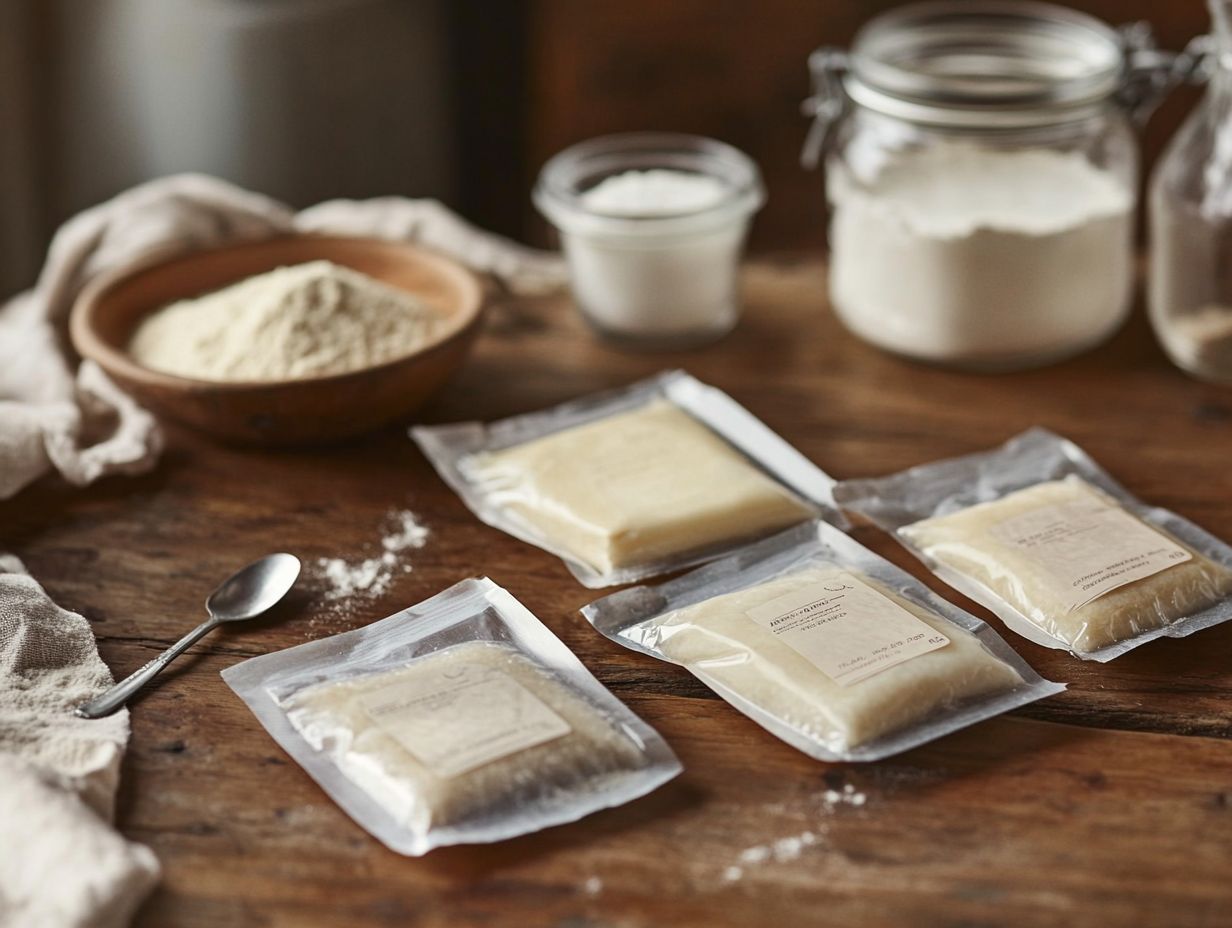
The proofing method is your go-to technique for testing yeast activity. Simply dissolve a small amount of yeast in warm water with a hint of sugar, and watch for bubbles and foam to emerge within minutes. This delightful reaction confirms that your yeast is alive and ready to work its magic in the dough.
Start proofing by measuring one teaspoon of dry yeast and adding it to a bowl with a quarter cup of warm water aim for a temperature between 95 F and 110 F for optimal activation. Next, stir in a teaspoon of sugar, which acts as nourishment for the yeast. This step is vital, so don t skip it!
Allow the mixture to sit undisturbed for five to ten minutes. You should see it bubbling and foaming this is a promising sign that fermentation is in full swing.
For successful proofing, be mindful of the water temperature. If it’s too hot, you risk killing the yeast, leading to disappointing results. If it’s too cold, you may not activate the yeast at all, causing unnecessary delays in your baking adventure.
Watch out for common pitfalls, such as using stale yeast or rushing the proofing time. These missteps can result in flat, dense baked goods that simply won t rise to your expectations.
Baking with Yeast: Essential Tests and Common Mistakes
1. Temperature Test
The temperature test is a highly effective method for checking yeast activity, ensuring that the yeast is kept at a warm, suitable temperature for activation. Yeast thrives best in a temperature range of 100 F to 110 F. This technique allows you to confirm that your yeast is viable before use.
To achieve accurate temperature readings, use a reliable kitchen thermometer to check the warmth of your water or mixture before adding the yeast. If you don t have a thermometer handy, test the temperature with your wrist; the liquid should feel warm but not hot to the touch.
For optimal yeast activation, it s essential to avoid extreme temperatures that could harm the yeast. Instead, opt for lukewarm water. Maintaining a consistently warm environment during the initial proofing stage by wrapping the bowl in a towel or placing it in a slightly warm oven can significantly enhance yeast activation. This ensures your baked goods rise properly and achieve the desired texture.
2. Smell Test
The smell test is an excellent way to quickly assess the freshness and activity of your yeast. Fresh yeast presents a pleasant, slightly sweet aroma that can set the stage for your baking masterpiece. However, if you catch a whiff of something sour or off, it s a clear warning that it has gone bad and should be avoided in your baking endeavors.
To perform the smell test effectively, open the yeast package and take a gentle sniff. Fresh yeast will typically greet you with an inviting aroma reminiscent of freshly baked bread or pastries, signaling that it s ready to work its magic.
If the scent brings to mind vinegar or a strong fermentation odor, it’s prudent to discard it. This test is crucial for your baking success. Using fresh yeast ensures a proper rise, contributes to a delicate crumb, and enhances the overall flavor of your baked goods.
Trust your nose; those olfactory clues can make all the difference, steering you from a successful bake to a regrettable outcome.
3. What Are the Common Mistakes When Using Yeast?
Using yeast in baking may seem simple, yet a few common missteps can yield disappointing results. From employing expired yeast to incorrect proofing techniques and adding salt directly to the yeast, these errors can significantly impact the dough’s rise and overall texture.
Avoiding these pitfalls is crucial for achieving the most satisfying baking results with your yeast.
1. Using Expired Yeast
Using expired yeast is one of the most common mistakes you can make as a baker, leading to disappointing results like poor rise and dense baked goods. Always check the expiration date and test the yeast’s activity before incorporating it into your baking for freshness and effectiveness.
When you use expired yeast, you might encounter lackluster outcomes, such as bread that refuses to rise or pastries that lack that desired fluffiness. The impact on your entire baking process can be significant since rising dough is crucial for achieving that perfect texture you crave.
To verify the freshness of your yeast, dissolve a small amount in warm water with a sprinkle of sugar and wait for it to foam up. If you don t see any bubbling after about five to ten minutes, that s your signal that the yeast has lost its magic.
By consistently checking the freshness of your yeast, you can sidestep these common pitfalls and elevate the quality of your delicious creations.
2. Using Water That Is Too Hot or Cold
Using water that s either too hot or too cold can disrupt yeast activation, resulting in lackluster fermentation and a disappointing rise in your dough. Yeast thrives within a precise temperature range, so for optimal activation, aim for water that s between 100 F and 110 F. This sweet spot is crucial for achieving successful baking results.
If the water exceeds this range, it can kill the yeast, leaving your dough flat and unappetizing. On the other hand, water that s too cold can stall the yeast s activity, leading to sluggish fermentation and a dense final product.
To nail the right temperature, use a reliable kitchen thermometer for accuracy. If adjustments are needed, you can easily add cooler water to warm water or gently heat it on the stove. By understanding and monitoring water temperature, you unlock the full potential of yeast, paving the way for delectable loaves and perfectly risen pastries.
3. Not Proofing the Yeast
Neglecting to proof the yeast can leave you uncertain about its viability, which may lead to flat or dense baked goods.
By taking the time to proof, you can check if the yeast is working before integrating it into your dough, ensuring dependable fermentation and rise during baking.
This essential step dramatically enhances the overall texture and flavor of your final product.
Proper proofing not only confirms that the yeast is alive and well, but it also assists you in achieving the perfect balance of ingredients, contributing to a light and fluffy crumb structure.
To successfully proof yeast, start by dissolving it in warm water, typically between 100 F to 110 F, adding a pinch of sugar to kickstart its activity. Waiting for bubbles to form within about five to ten minutes is crucial, as this signifies that fermentation the process where yeast converts sugars into carbon dioxide and alcohol is underway.
By adding this practice to your baking routine, you’ll see more consistent and delicious results every time!
4. Adding Salt Directly to Yeast
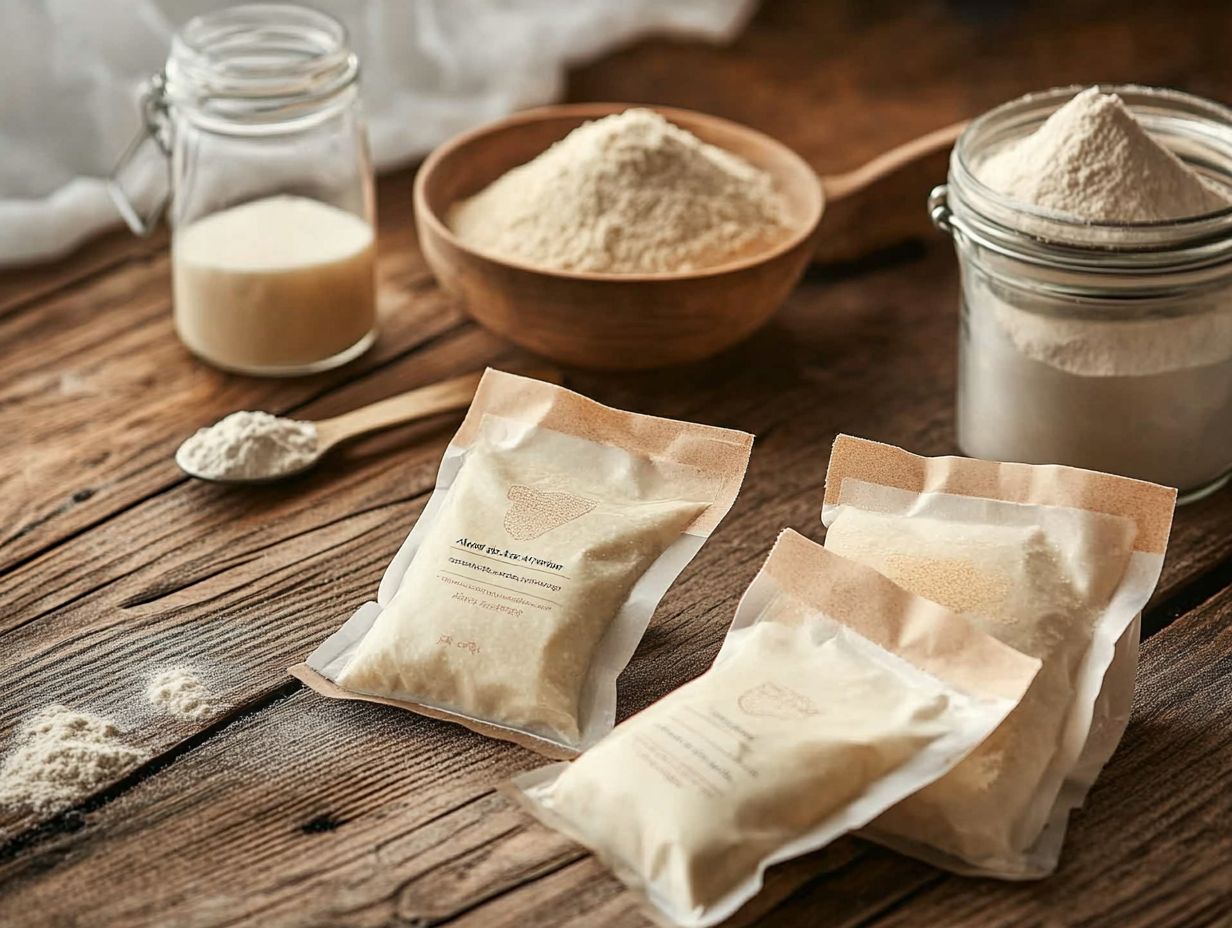
Adding salt directly to yeast can undermine yeast activity, as excessive concentrations may kill yeast cells and hinder proper dough rising.
It’s essential to adhere to recipes that detail when and how to incorporate salt, ensuring that the yeast remains active throughout fermentation.
Understanding the interplay between salt and yeast is crucial for achieving the ideal texture and flavor in your baked goods.
Salt not only enhances taste but also plays a significant role in regulating yeast fermentation by controlling how quickly yeast ferments sugars.
When introduced at the right moment, salt can fortify the gluten structure and create a harmonious flavor profile.
If salt is mixed directly with yeast before hydration, it can create an imbalance that disrupts the entire process.
For bakers, mastering the timing of salt addition is key to achieving the perfect rise and crumb in their bread, resulting in a delightful experience with each bite.
Frequently Asked Questions
Here are some common questions about choosing the right yeast that can help improve your baking.
How Do I Choose the Right Yeast?
Choosing the right yeast for your recipe can be daunting, but here are some frequently asked questions to help guide you.
What factors should I consider when choosing yeast?
Consider the type of recipe, desired flavor profile, and fermentation temperature when choosing the right yeast for your recipe.
What is the difference between active dry yeast and instant yeast?
Active dry yeast needs to be activated in warm water, while instant yeast can be added directly to dry ingredients. For example, instant yeast has a smaller particle size, allowing for a quicker rise time.
Can I use any type of yeast for bread making?
While most yeast can be used for bread making, certain types such as brewer’s yeast or nutritional yeast may not produce the desired results.
How can I determine the best yeast to use for my recipe?
Researching and trying different types of yeast can help determine the best one for your recipe. You can also consult with experienced bakers for their recommendations.
Can I substitute one type of yeast for another in a recipe?
In most cases, yes, you can substitute one type of yeast for another. However, keep in mind that different types of yeast may have varying rise times and may affect the flavor of your final product.
Should I use fresh or dried yeast for my recipe?
Fresh yeast has a shorter shelf life and needs to be refrigerated, while dried yeast has a longer shelf life and can be stored at room temperature.
Consider the expiration date and storage options when choosing between fresh and dried yeast.


